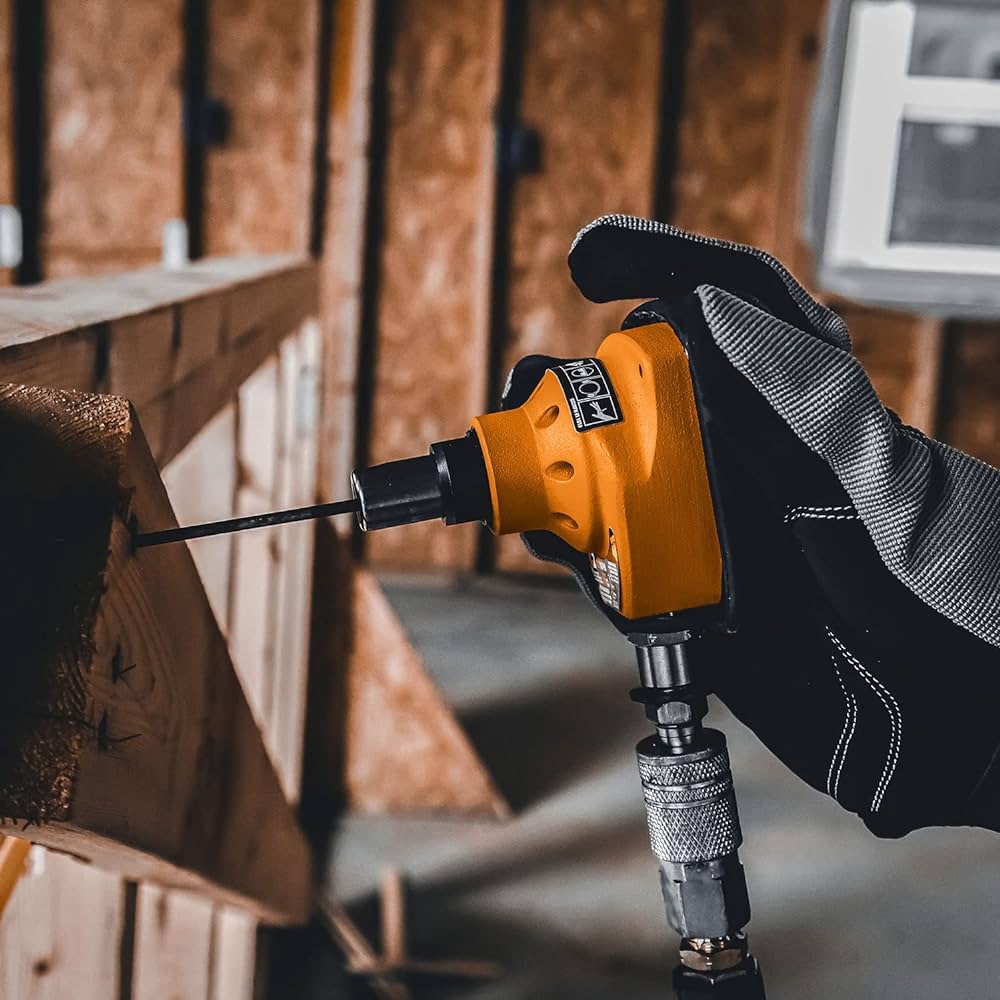If you are looking for an easy-to-use and powerful tool for finishing small projects around the house, a palm nailer may be just what you need. It’s very similar to a pneumatic nail gun but with a few key differences.
These tools are ideal for any DIY projects that require precision. They are designed to drive nails quickly and accurately without the use of a compressor or air hose.
What is a Palm Nailer?
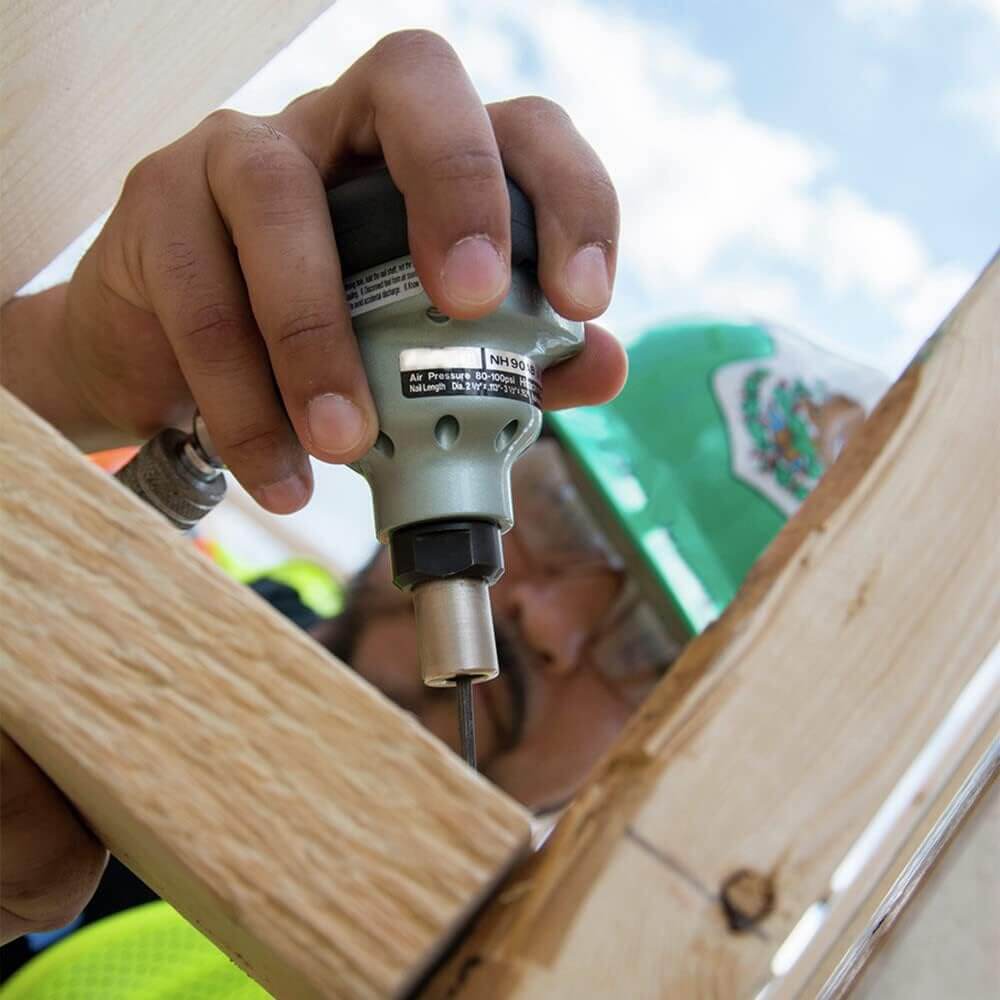
As you can guess by the name, a palm nailer is a type of fastening tool that fits into the palm of your hand. It works by striking a nail head and sinking it into wood or other material, much like a hammer and nails.
A palm nailer or palm nail gun is also known as palm sized or mini nail gun. These nail guns are commonly made from lightweight aluminum or durable steel. Some palm nail guns have plastic components, especially for non-structural parts like handles, covers, or safety mechanisms.
The main difference between a regular hammer and a palm nailer is that the latter uses an internal mechanism to hit the nail faster than you could with your own two hands.
This approach not only makes the job easier and faster but also ensures greater accuracy, as you drive the nail into the surface exactly where you want it.
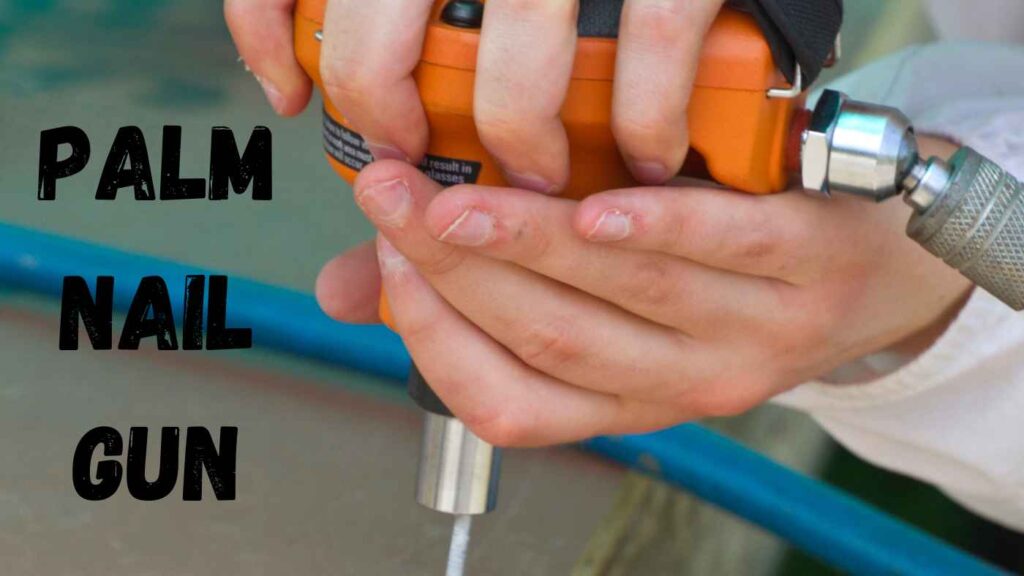
Palm nailers are extremely lightweight and designed to fit appropriately in your hand. This diminishes fatigue from extended overhead nailing or using heavy coil roofing nailers.
Thanks to their smaller size and lightweight construction, you can use palm nailers in tight spaces like furniture or door frames.
These nailers are easy to maneuver and cheaper than other types of nailers such as brad, finish, and framing nailers.
Palm nailers are fairly simple tools with fewer moving parts than framing or finish nailers. As long as you keep and store them properly lubricated, they necessitate little maintenance.
How Does a Palm Nailer Work?
A palm nailer is a small tool designed to drive nails into wood or other materials precisely. Its compact design makes it perfect for working in tight spots where a regular nail gun or hammer wouldn’t fit.
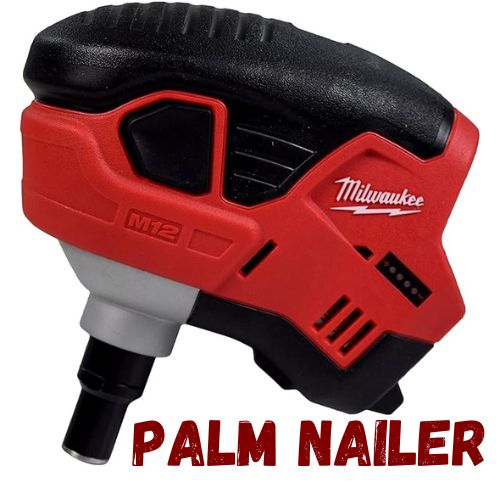
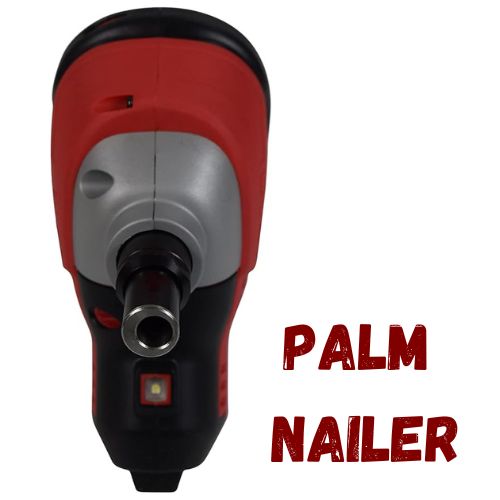
Here’s a short explanation of how it works:
Power Source
Most palm nailers are powered by compressed air, making them pneumatic tools. However, some models run on batteries, offering a cordless option. The power source provides the force needed to drive the nails.
Operation
- Loading the Nail: Unlike regular nail guns that use a strip of nails, palm nailers handle one loose nail at a time. You place the nail in the magnetic guide at the front of the tool, which holds it securely.
- Positioning: Once the nail is loaded, align the nailer over the spot where you want the nail to go.
- Activation: Palm nailers don’t usually have a trigger. Instead, they activate when you press them firmly against the surface. This pressure signals the tool to start working.
Driving the Nail
When activated, the palm nailer uses quick, hammer like blows to drive the nail into the material. This repeated motion ensures the nail goes straight and stays securely in an accurate place.
Control & Precision
Palm nailers fit comfortably in your hands. It gives you excellent control over where and how you drive the nail. This makes them ideal for tasks like:
- Nailing in tight spaces, such as corners or joist hangers.
- Projects where nails need to be placed with precision, like decking or framing.
How to Use a Palm Nailer?
Just like any other nailer, a palm nailer uses the same mechanism to drive nails into the material but with a few key differences.
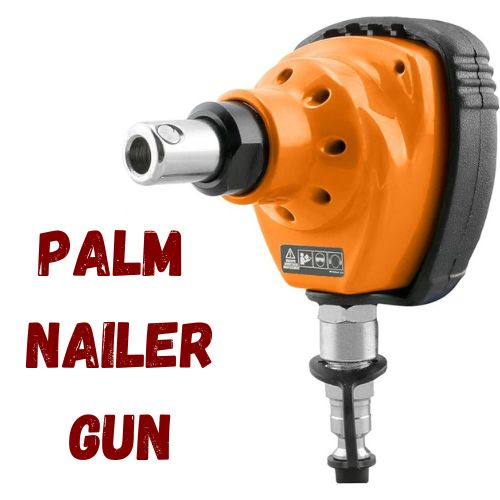
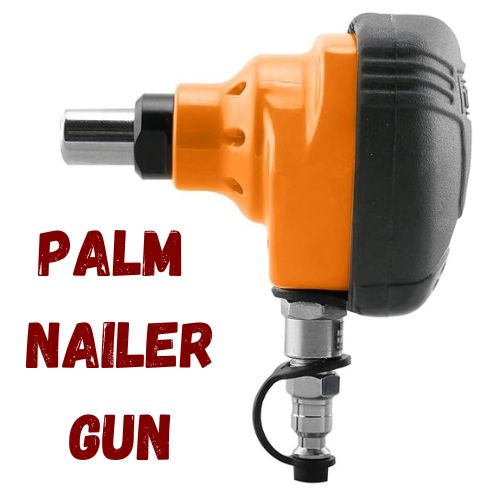
Before you start using your palm nailer, it is important to read the instructions that come with the tool and understand how it works.
Make sure you have all the necessary safety equipment in place before beginning your project.
Here’s how to use a palm nailer:
Safety first
Make sure that you are wearing proper safety gear such as gloves and goggles before you start working. Palm nailers are not that powerful, but they can still cause damage if you are not careful.
Choose the right nails
It is important to use the correct size and type of fasteners for your project. The wrong nail can cause damage to the material or even jam the nailer itself.
Load the nail
Load the nail into the palm nailer by pressing it against the nailer’s nose and sliding it down until it clicks into place.
Position the nail
Place your thumb on the trigger and position the head of the fastener where you want to drive it. Make sure that you are working in a steady, comfortable position.
Press the trigger
Gently press the trigger and feel it depress as the nail is driven into the material. Release the trigger after each shot for the best results.
Repeat
Once you reach your ideal depth, you can repeat the process until your project is complete.
Pros & Cons of a Palm Nail Gun
Pros of a Palm Nail Gun
Compact and Lightweight
Palm nailers are small and easy to handle. They are perfect for tight spaces where larger nail guns or hammers can’t fit. Their lightweight design helps reduce hand fatigue issues during long projects.
Precision & Control
The hand held design provides better accuracy, especially in detailed or confined areas. The magnetic nail guide holds the nails in place. It makes the operation smoother.
Versatility
Palm nailer guns handle a wide range of nail sizes, from small finishing nails to large framing nails. They are useful for a variety of tasks, like framing, decking, joist hangers, and fencing.
Ease of Use
The tool activates automatically when pressed against the material. Palm nailers have no trigger.
Therefore, they don’t need any trigger mechanism during work. It’s simple enough for both beginners and professionals to use.
Powerful Performance
Delivers quickly and can drive nails into tough materials like hardwood or dense framing. Reduces the physical effort compared to manually hammering nails.
Affordability
Palm nailer guns are often cheaper than other full sized nail guns. They are a budget friendly option for certain jobs.
Portability
Their compact size makes them easy to carry and ideal for use on job sites.
Cons of a Palm Nail Gun
Slower Speed
Palm nailers drive one nail at a time, which makes them slower for large scale projects compared to strip or coil fed nail guns.
Limited Applications
They aren’t ideal for tasks requiring fast, repetitive nailing, like installing roofing or sheathing. Best suited for precision work rather than high speed production.
Requires a Power Source
Pneumatic models need an air compressor, which reduces portability if a compressor isn’t available. Cordless models rely on batteries that may run out during extended use.
Noise & Vibration
Palm nailers can be noisy, but quieter than pneumatic nail guns. These tools rely on compressed air or electricity to drive nails, and the sound of the nail striking the material produces a noticeable hammering noise.
For pneumatic models, the air compressor can also contribute to the overall noise level. If you’re working in a closed area or using the tool for long periods, put on a hearing protection.
Tool Learning
Although simple to operate, it can take time for beginners to get used to how the tool works.
Ergonomic Limitations
Even with ergonomic designs, extended use can lead to hand fatigue, particularly for those who have smaller hands.
Not Ideal for Long Nails
While palm nailers can handle large framing nails, they might struggle with very long or specialized nails depending on the model.
Here is a summary of pros and cons of palm nailer guns:
| Aspect | Pros | Cons |
| Size and Weight | Compact and lightweight; easy to handle. | Extended use may cause hand fatigue, especially who have smaller hands. |
| Precision and Control | Provides better accuracy and control in tight or awkward areas; magnetic nail guide included. | May need a bit of practice for beginners to adjust to the tool’s operation. |
| Versatility | Can handle various nail sizes and is useful for framing, decking, fencing, and joist hangers. | Struggles with exceptionally long or specialized nails. |
| Ease of Use | Simple to operate; activates automatically when pressed against the surface. | Beginners may experience a slight tool learning training initially. |
| Performance | Delivers nails quickly into tough materials like hardwood. | Slower than strip and coil fed nail guns; only drives one nail at a time. |
| Affordability | More affordable than full sized nail guns. | Not suited for high speed jobs like installing roofing shingles or sheathing. |
| Portability | Compact and easy to carry on job places. | Pneumatic models need an air compressor, and cordless ones rely on batteries. |
| Noise and Vibration | N/A | Noisy but not like larger pneumatic models of traditional nail guns. Sometimes, create annoying vibration. |
Key Features of Palm Nailers
Plam nail guns come with various types of features that enable them to apply in different types of projects and materials.
Here are the key features:
Compact Size
The palm nail gun is small and lightweight nail gun. It is easy to use in tight and edged spaces. It fits comfortably in your hand, which helps you handle it easily.
Versatility
It works with many different nail sizes, from small brads to large framing nails. This tool is great for tasks like decking, fencing, framing, and installing joist hangers.
Triggerless Operation
Most palm nail guns activate automatically when pressed against the material. There’s no need to pull a trigger, making it simpler to use.
Magnetic Nail Guide
The nail gun has a magnetic tip that holds nails in place. This helps you place nails accurately into the materials. As a result, it provides you a better output.
Pneumatic or Cordless Options
Pneumatic models are powered by compressed air, giving them steady performance. Cordless models run on batteries, offering you the freedom to work anywhere.
Powerful Performance
Palm nail guns use rapid and hammer like blows to drive nails into tough materials like hardwood. This reduces the effort needed compared to using a manual hammer.
Ergonomic Design
The gun is designed to fit comfortably in your palm to give you better control and less strain. It often has padded or rubber grips for extra comfort.
Durability
Palm nail guns are built to last, even under heavy use. The body and frame of palm nail guns are usually made from lightweight aluminum or durable steel. These materials make the tool more durable.
Portability
These mini nail guns come with high portability because of being small and lightweight. Therefore, they are easy to carry from one job site to another.
Cost Effective
These palm sized nail guns are more affordable than larger nail guns. They are a great choice for smaller tasks or specialized jobs.
What is a Palm Nailer Used for?
Palm nail guns are versatile tools designed for tasks that need precision and access to tight spaces.
Here are some common applications of this versatile mini sized nailer gun:
Joist Hangers and Framing Connections
These palm sized nailers are perfect for driving nails into tight spots, like securing joist hangers to beams in floor framing.
Furthermore, they are great for nailing in hard to reach areas of framing, especially in corners or places where larger framing nail guns can’t reach.
Decking and Fencing
Palm nailers provide precision when nailing in decking projects, especially in narrow spaces between deck boards or when using smaller nails.
Moreover, they are useful for fence construction, especially when securing rails to posts or driving nails into hard to reach spots in a fence.
Installing Baseboards and Trim
Palm nailer guns help secure baseboards to walls, especially in areas where space is limited between the trim and wall.
They are also ideal for detailed trim work. These mini nailers ensure accurate nail placement without damaging delicate wood.
Roofing
These nailers are helpful in roofing applications, particularly for securing nails in tight spaces around ridge caps or eaves.
You can also apply these nail guns for attaching roof underlayment or shingles where space is limited.
Installing Hard to Reach Nails
Palm nailers are perfect for tight, awkward spaces where larger tools can’t fit, like areas under cabinets, between studs, or in beams.
These tools can drive nails at angles where larger nail guns struggle. They assure a clean and precise finish.
Woodworking and Cabinet Making
Palm nail guns are popular among woodworkers for driving small nails in delicate projects, like cabinetry or trim works. Their small size makes them ideal for precise and detailed tasks.
Installing Nails for Flooring
Palm nail guns are useful while installing hardwood floors, especially in tight corners or near walls where larger tools don’t fit.
Framing Light Construction
While not as fast as full sized framing nail guns, palm nailers can be used for light framing work, like building small sheds, light structures, or home improvement projects.
Furniture Assembly
Palm nailers are sometimes used for furniture assembly, especially when putting together smaller wooden parts or pieces that need careful handling to avoid damaging the wood.
Power Sources of Palm Nail Guns
Like other nail guns, palm nailers also come with various types of power sources. They come with 3 main power sources. They are pneuamtic, cordless or batter powered, and electric (corded).
Pneumatic Palm Nailers (Most Common Type)
- Power Source: These nailers run on compressed air supplied by an air compressor.
- How It Works: The air compressor creates pressurized air, which travels through a hose to power up the nailer’s internal piston. The piston delivers enpough power to drive nails into materials.
- Pros:
- Strong and reliable. Great for heavy duty tasks.
- Can run continuously as long as the compressor is running.
- Ideal for demanding jobs like framing.
- Cons:
- Requires an air compressor and hose. These equipment reduces portability and increases weight.
- The pneumatic version of this mini nail gun creates loud noise than other versions.
2. Cordless/Battery Powered Palm Nailers
- Power Source: They use rechargeable batteries, either lithium-ion or Ni-Cad.
- How It Works: A battery powers an electric motor inside the palm nailer. The motor drives the hammering mechanism, which delivers the force required to drive nails properly.
- Pros:
- Portable and easy to handle since there’s no need for a compressor or hose.
- Convenient for quick or small tasks, especially in tight spaces.
- Cons:
- Limited battery life means you might need to recharge during longer projects.
- You have to notice whether the battery is getting low. It is wise to keep extra battery with full charge during longer projects.
- Less powerful than pneumatic models. Therefore, they’re not ideal for dense materials.
3. Electric (Corded) Palm Nailers
- Power Source: These nailers plug directly into an dedicated electrical outlet.
- How It Works: Electricity powers an internal motor, which operates the hammering mechanism to drive nails.
- Pros:
- No need for a battery or air compressor.
- Provides consistent performance without interruptions like running out of air or battery charge.
- Cons:
- Mobility is limited because the tool depends on power outlets and cords.
- You can carry them to your job sites, but before that, you have to ensure a standard electric outlet in your job sites.
- These are less common compared to pneumatic and battery powered models.
FAQs
1. What kind of nails to use with a palm nailer?
Ans: Palm nailers are mostly used with large framing nails, joist hanger nails, or other bulk nails.
2. Can you remove nails with a palm nailer?
Ans: No, you cannot. Palm nailers are designed to drive nails and not remove them. To remove a nail you need to use a claw hammer or another prying tool.
3. Can You Use Finishing nails in palm nailers?
Ans: Yes, you can use finishing nails in a palm nailer – however, it is important to check the size and type of fastener that the tool can handle before purchasing. Some palm nailers are not suitable for very small or thinner nails.
4. Can you use a palm nailer for roofing?
Ans: Yes, you can! Roofing requires a lot of fastening and palm nailers are perfect for the job. They can easily access hard-to-reach areas, making them ideal for roofs. Just make sure to use the correct size and type of nails for this application.
5. Are palm nailers worth it?
Ans: Yes, it is sure that, a palm nailer is worth it tool for driving nails in tight spaces. But similar to other nail guns, this nailer also have some exciting advantages and unavoidable drawbacks. Like they are slower than other nail guns.
So, the worthiness of this tool actually depends on what you specifically want to do. And it depends on your project and material type.

